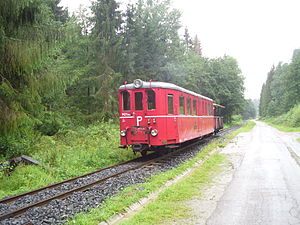ČSD series M 21.0
| ČSD series M 21.0 | |
|---|---|
| Numbering: | M 21.001–009 |
| Number: | 9 |
| Manufacturer: | Tatra Mountains Kopřivnice |
| Year of construction (s): | 1937-1948 |
| Retirement: | 1965 |
| Axis formula : | B'2 ' |
| Gauge : | 760 mm ( Bosnian gauge ) |
| Length over buffers: | 13,910 mm |
| Length: | 12,990 mm |
| Height: | 3,050 mm |
| Width: | 3,100 mm |
| Trunnion Distance: | 8,200 mm |
| Bogie axle base: | 1,800 mm |
| Total wheelbase: | 10,000 mm |
| Service mass: | 16.5 t |
| Wheel set mass : | 11 t |
| Top speed: | 45 km / h |
| Installed capacity: | 120 hp |
| Driving wheel diameter: | 620 mm |
| Wheel diameter: | 620 mm |
| Motor type: | 1 × Tatra 10 |
| Motor type: | 6-cylinder gasoline engine |
| Rated speed: | 1,800 rpm |
| Power transmission: | mechanically |
| Seats: | 38 |
| Classes : | 3. |
As CSD-Series M 21.0 were narrow gauge engine railcar of the former Czechoslovak State Railways designated CSD, as further development of the CSD-Series M 11.0 were used from 1938 to the various narrow gauge railways.
history
The use of the M 11.0 series brought the Czechoslovak State Railways a significant reduction in travel times and other operational advantages. The disadvantages of this type were the insufficient number of seats and the too high fixed wheelbase, which put too much stress on the tracks.
That is why the Tatra company in Kopřivnice ( Nesselsdorf ) developed this four-axle narrow-gauge railcar in the mid-1930s. The vehicles designated as series M 21.0 were equipped with two end driver's cabs and two passenger compartments.
technical features
The vehicles were powered by the six-cylinder Tatra gasoline engine, which was already used in the ČSD M 120.4 series. While with the M11.0 the change of direction was practiced with a reversing gear , here it was done with reversing motors like those used in the M 120.4. Otherwise they had the four-speed planetary gearbox for power transmission , which was used on all Tatra railcars.
For the first time, a vehicle with two terminal cabs was manufactured at Tatra. It had two passenger compartments with a total of 38 seats. The benches were wooden benches with padded backrests. The exhaust gases from the engine were used for heating.
The railcars M 21.001 and M 21.002 were supplied by the manufacturer with dark green side paint, white roof and frame and gray or black bogies. The railcars M 21.003 and M 21.004 were painted red-brown, the M 21.005-M 21.009 painted red.
Operational use
The railcars provided service on the narrow-gauge railways in Jindřichův Hradec , Osoblaha and on the Borschatalbahn . They remained in use on these local railways during the Second World War . Like the M 11.0 series, this made them stand out from the standard gauge ČSD motor vehicles, which had to be parked due to a lack of fuel.
After the war, the vehicles did not have a long service life. Operation with the gasoline engine was viewed as negative, and there were also problems with the transmission. Tatra could no longer supply spare parts. After the delivery of the ČSD series T 47.0 , the vehicles were replaced by the latter and taken out of service until 1964. Some vehicles were sold to other operators and converted into sidecars.
Vehicle M 21.004 has been preserved as an operational vehicle and is used as a museum at the Schwarzgranbahn in Čierny Balog . Externally and in the interior it was restored to the original, but the drive system and the controls of the vehicle were modernized. In Čierny Balog, the M 21.006 is still preserved as a sidecar, three other vehicles are available in Nitra and Pribylina .
See also
literature
- Eisenbahn-Kurier 9/2005: Vehicle history. EK-Verlag, Freiburg 2003,
